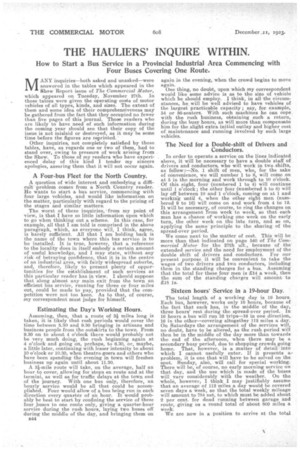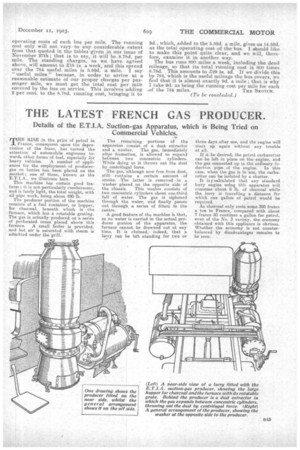THE HAULIERS' INQUIRE WITHIN.
Page 28

Page 29

If you've noticed an error in this article please click here to report it so we can fix it.
How to Start a Bus Service in a Provincial Industrial Area Commencing with Four Buses Covering One Route.
MANY inquiries—both asked and unasked—were answered in the tables which appeared in the Show Report issue of The Commercial Motor, which appeared on Tuesday, November 27th. In those tables -were given the operating costs of motor vehicles of all types, kinds, and sizes. The extent of them and some idea of their comprehensiveness may be gathered from the fact that they occupied no fewer than five pages of this journal. Those readers who are likely to have need of such information during the coming year should see that their copy of the issue is not mislaid or destroyed, as it may be some time before the figures are reprinted.
Other inquiries, not completely satisfied by those tables, have, as regards one or two of them, had to stand over, owing to pressure of work arising from the Show. To those of my readers who have experienced delay of this kind I tender my sincere apologies, assuring them that it will not occur again.
A Four-bus Fleet for the North Country.
A question of wide interest and embodying a difficultproblem comes from a, North Country reader. He wants to start a bus service, commencing with four large vehicles, and would like information on the matter, particularly with regard to the pricing of the stages and similar matters.
The worst of these inquiries, 'from my point of view, is that I have so little information upon which to go when thinking out a scheme. In this case, for example, all that I am told is comprised in the above paragraph, which, as everyone will, I think, agree, is barely sufficient. All that I am holding back is the name of the town where this bus service is to be installed. It is true, however, that a reference to the locality does in itself embody a certain amount of useful knowledge, and I may state, without any risk of betraying confidence, that it is in the centre of an industrial area with fairly widespread suburbs, and, therefore, likely to present plenty of opportunities for the establishment of such services as this particular reader has in view. I should suppose that along almost any main exit from the town an efficient bus service, running for three or four miles out, could be made to pay„ provided that the competition were not too keen. As to that, of course, my correspondent must judge for himself.
Estimating the Day's Working Hours.
Assuming, then, that a route of 34 miles long is taken, it is likely that rush periods would cover the time between 5.20 and 9.30 bringing in artisans and business people from the outskirts to the town. From 9,30 on to about 4 o'clock there would probably not be very much doing, the rush beginning again at 4 o'clock and going on, perhaps, to 6.30, or, maybe, a little later, continuing with lesser intensity to about 10 o'clock or 10.30, when theatre-goers and others who have been spending the evening in town will freshen business up again until about 11.30.
A 34-mile route will take, on the average, half an hour to cover, allowing for stops en route and at the termini, as well as for traffic delays at the town end of the journey. With one bus only, therefore, an hourly service would be all that could be accomplished. Four would allow of a bus being run in each direction every quaster of aia hour. It would probably be best to start by confining the service of these four jouses to one route only, giving a quarter-hour service during the rush hours, laying two buses off during the middle of the day, and bringing them on B44 again in the evening, when the crowd begins to move again. One thing, no doubt, upon which my correspondent would like some advice is as to the size of vehicle which he should employ. I think, in all the circumstances, he will be well advised to have vehicles of the largest practicable capacity ; say, for example, 54 or 56-seaters. With such machines he can cope with the rush business, obtaining such a return, during the busy hours, as will more than compensate him for the slight extra initial outlay and higher cost of maintenance and running involved by such large vehicles.
The Need for a Double-shift of Drivers and Conductors.
. In order to operate a service on the lines indicated above, it will be necessary to have a double staff of drivers and conductors, who will work in two shifts, as follow:—No. 1 shift of men, who, for the sake of convenience, we will number 1 to 8, will come on at 5 in the morning and work through to 10 o'clock. Of this eight, four (numbered 1 to 4) will continue until 1 o'clock; the other four (numbered 5 to 8) will lay off between 10 and '1 o'clock, coming on at 1 and workin-g until 4, when the other eight men (numbered 9 to 16) will come on and work from 4 to 12. It will be necessary, of course, to ring the changes on this arrangement from week to week, so that each man has a chance of working one week on the early turn, the other week on the late turn' and 90 on, applying the same' principle to the sharing of the spread-over period.
We come next to the matter of cost. This will be more than that indicated on page 540 of The Commercial Motor for the 27th ult., because of the extended service and the need for employment of the double shift of drivers and conductors. For our present purpose it will be convenient to take the wages of two drivers and two conductors, including them in the standing charges for a bus. Assuming that the total for these four men is £14 a week, then the sum of the standing charges will amount, to £18 Is.
Sixteen hours' Service .in a I9-hour Day.
The total length of a working day is 19 hours. Each bus, however, works only 16 hours, because of the fact that each has, in the middle of the day, three hours' rest during the spread-over period. In 16 hours a bus will run 32 trips-16 in one direction, 16 in the other—covering altogether 112 miles a day. On Saturdays the arrangement of the services will, no doubt, have to be altered, as the rush period will then be in the middle of the day more than towards the end of the afternoon, when there may be a secondary busy period, due to shopping crowds going home. That, however, is •a matter of detail -into which I cannot usefully enter. If it presents aproblem it is one that will have to be solved on the spot. Sunday, also, will call for special working. There will be, of course, no early morning service on that day, and the use which is made of the buses will vary considerably with the weather. On the whole, however, I think I may justifiably assume that an average of 112 miles a day would be covered seven days a week, so that the total weekly mileage will amount to 784 net, to which must be added. about 2 per cent. for dead running between garage and route, giving us a round total of about 800 miles a week.
We are now in a position to arrive at the total operating costs of each bus per mile. The running cost only will not vary to any considerable extent from that quoted in the tables given in our issue of November 27th; that is to say, it will be 8.78d. per mile. The standing charges, as we have agreed above, will amount to 218 is. a week, and this spread over the 784 useful miles is 5.52d. a mile. I say "useful miles " because, in order to arrive at a reasonable estimate of our proper charges per passenger mile, we must get the total cost per mile covered by the bus on service. This involves adding 2 per cent, to the 8,78d. running cost, bringing it to 9d., which, added to the 5.52d. a mile, gives us 14.52d. as the total operating cost of the bus. I should like to make this point quite clear, and we will, therefore, examine it in another way.
The bus runs 800 miles a week, including the dead mileage, so that its total running cost is 800 times 8.78d. This amounts to -C29 5s. 4d. If we divide this by 784; which is the useful mileage the bus covers, we and that it is almost exactly 9d. a mile ; that is why I take 9d. as being the running cost per mile for each .of the 784 miles. TEE SKoTcH.
































